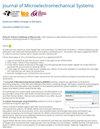Experimental and Simulative Correlations of the Influence of Solder Volume and Receptor Size on the Capillary Self-Alignment of Micro Solar Cells
IF 2.5
3区 工程技术
Q2 ENGINEERING, ELECTRICAL & ELECTRONIC
引用次数: 0
Abstract
Surface tension-driven self-alignment is a promising technique to align millimeter-scale components with a high accuracy of a few microns. It is based on liquid capillary forces moving and aligning a solid component on its receiving pad. Using molten solders as the liquid is a promising way to bond, connect and align a chip with its substrate. Micro-solar cells soldering experiments for micro-concentrator photovoltaics have been carried out. It has been found experimentally that the solder volume, the receiving pad size and the initial placement of the chip have an impact on the placement accuracy. In this work, an analytical and a numerical model of the capillary forces during self-alignment are built to improve the understanding of the experimental results. Guidelines to reach a high placement accuracy are presented. In practice, low solder volumes, receiving pads smaller than the chip and an initial chip displacement of about 10% of the chip size yield a higher placement accuracy. [2023-0153]焊接体积和受体尺寸对微型太阳能电池毛细管自对准影响的实验和模拟相关性
表面张力驱动的自对准是一种很有前途的技术,可对准毫米级元件,精度高达几微米。它基于液体毛细力在接收垫上移动和对齐固体元件。使用熔融焊料作为液体是一种很有前途的将芯片与其基板粘合、连接和对齐的方法。针对微型聚光光伏电池的微型太阳能电池焊接实验已经完成。实验发现,焊接量、接收焊盘尺寸和芯片的初始位置都会影响贴装精度。在这项工作中,建立了自对准过程中毛细力的分析和数值模型,以加深对实验结果的理解。同时还提出了达到高贴装精度的指导原则。在实践中,低焊接量、小于芯片的接收焊盘以及芯片初始位移约为芯片尺寸的 10%,都能获得较高的贴装精度。[2023-0153]
本文章由计算机程序翻译,如有差异,请以英文原文为准。
求助全文
约1分钟内获得全文
求助全文
来源期刊

Journal of Microelectromechanical Systems
工程技术-工程:电子与电气
CiteScore
6.20
自引率
7.40%
发文量
115
审稿时长
7.5 months
期刊介绍:
The topics of interest include, but are not limited to: devices ranging in size from microns to millimeters, IC-compatible fabrication techniques, other fabrication techniques, measurement of micro phenomena, theoretical results, new materials and designs, micro actuators, micro robots, micro batteries, bearings, wear, reliability, electrical interconnections, micro telemanipulation, and standards appropriate to MEMS. Application examples and application oriented devices in fluidics, optics, bio-medical engineering, etc., are also of central interest.
 求助内容:
求助内容: 应助结果提醒方式:
应助结果提醒方式:


